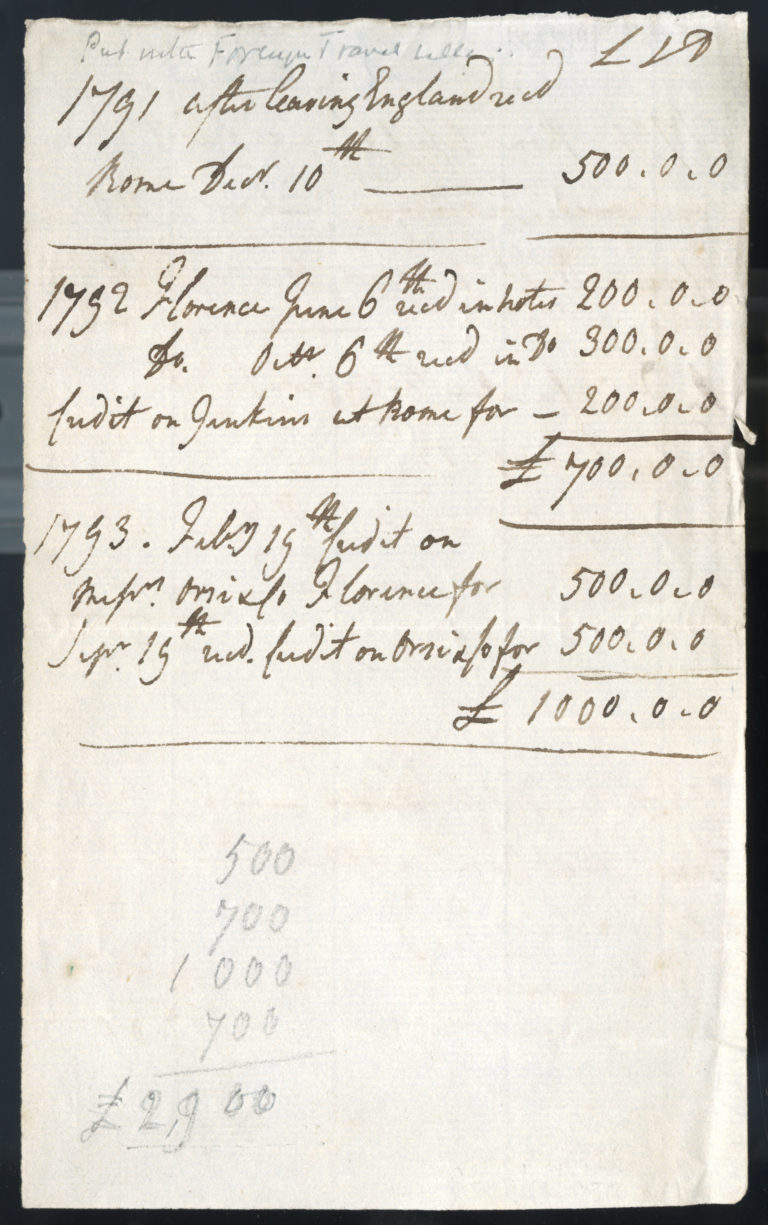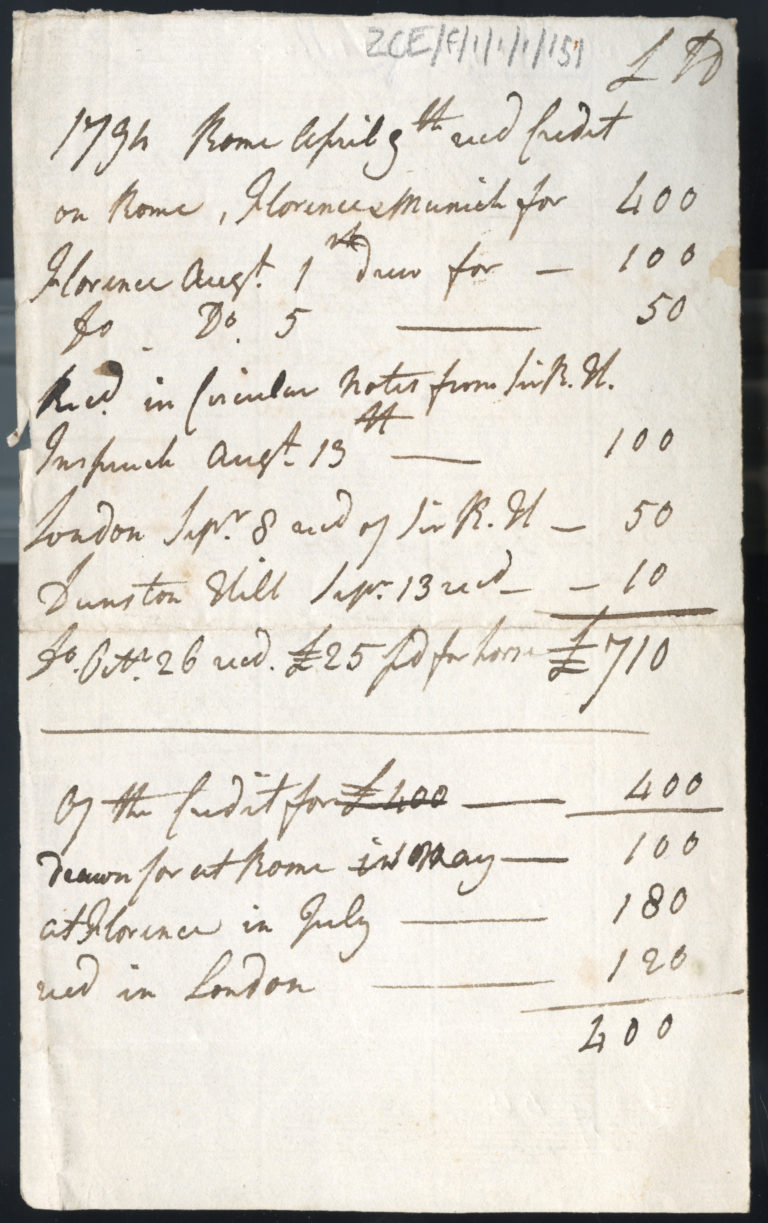Record of Money Received by John Carr from Ralph Carr While In Italy, 1791 – 1794
Reference: ZCE F/1/1/1/151
Suggested age groups: KS2, KS3, KS4, Lifelong Learners
Subject areas: History, Maths, Geography, Literacy


CONTEXT
During the 18th and 19th century, it was fashionable for wealthy British families to send their sons, and occasionally daughters, on a Grand Tour. This saw privileged young men and women setting off usually from London to travel across Europe. The tourists were affluent enough to spend multiple years on the Tour. They would often carry letters of introduction with them to mix with society while abroad.
John Carr (1764-1817) and Harriet Carr (1771-1848) were siblings who set out on their Grand Tour in 1791, returning to England in 1794. They were the children of successful northern businessman Ralph Carr and his wife Isabella.
Ralph and Isabella were initially against Harriet going on the Grand Tour but eventually gave their approval because it was thought that the tour would benefit Harriet’s health – she had a cough thought to be tuberculosis. Some of their objections were around fears of the political situation in Europe and potential dangers to travellers. John and Harriet’s ultimate destination was Italy, travelling via France and Switzerland.
John and Harriet spent almost six months in Rome with short trips to Bologna, Florence, Naples, and Turin. They had planned to leave for England in early 1792 but the outbreak of the Franco-Austrian War prevented this. They returned to Florence in May 1792, staying there until November 1793. In December 1793 John and Harriet made a final visit to Rome before leaving for England and arriving home in the summer of 1794.
Ralph Carr (1711-1806) was a Newcastle based merchant who was involved in banking, the import and export of goods to Europe and America, landholding, ship owning and underwriting. Ralph’s financial success had allowed the family to move from merchant to gentry status. Ralph was money-smart and was able to increase the family wealth considerably. When Ralph died in 1806 he was worth about £200,000.
This is a note written by John Carr listing the money given by his father to fund the Grand Tour.
The note records a total spending of £2910 over the entire trip – August 1791-September 1794. The Bank of England Inflation Calculator shows that this amount is equal to about £412,000 today. It has been suggested that this was quite a small amount for a three-year Grand Tour for two people and their servants.
It was dangerous for people to carry money while on the Grand Tour as there was a risk of robbery. Instead, tourists relied on letters of credit. These were agreements that allowed the tourist to draw money from their British bank’s agents in the major tourist cities aboard.
The major costs of the Grand Tour were accommodation, food, and transport. John and Harriet travelled in a family carriage but took the precautions of removing the coat of arms that decorated the carriage before setting off on their tour.
Accommodation was required for four people – John, Harriet and their servants, Dolly, and Stephen. Travel costs included the hire of a postilion or guide who was familiar with the route, and stabling and food costs for horses.
Tourists also spent money on clothing and entertainment. If the Tour was a long one, new clothes may be needed, and tourists were expected to dress well with some being keen to follow local fashions.
Entertainment, for example, theatre and opera, were generally inexpensive.
1791 After leaving England recd. [received]
Rome Decr. [December] 10th 500 0s 0d
1792 Florence June 6th recd. [received] in notes 200 0s 0d
Do. Octr. 6th 6th recd. [received] in do. 300 0s 0d
Credit on Jenkins at Rome for 200 0s 0d
£700 0s 0d
1793 Feby 19th Credit on
Messrs. Orsi & Co. Florence for 500 0s 0d
Sept. 19th recd. Credit on Orsi & Co. for 500 0s 0d
£1000 0s 0d
1794 Rome April 9th recd. [received] Credit
On Rome, Florence, Munich for Florence 400
Florence Augt. 1 drew for 100
Do. Do. 5 drew for 50
Recd. [received] in Circular Notes from Sir. R.H.
Inspruck [Innsbruk] Aug. 13th 100
London Sepr. 8 recd. [received] of Sir. R.H. 50
Dunston Hill Sepr. 13 recd. recd. [received] 10
Do. Oct. 26 recd. [received] £25 paid [?] for horse £710
Of the Credit for £400 400
drawn for at Rome in May 100
at Florence in July 180
recd. [received] in London 120
400
ACTIVITIES
ACTIVITY 1
Background
During the 18th and 19th century, it was fashionable for wealthy British families to send their sons, and occasionally daughters, on a Grand Tour of Europe. This saw privileged young men and women setting off usually from London to travel across Europe. The tourists were affluent enough to spend multiple years on the Tour. They would often carry letters of introduction with them to integrate into society while abroad.
SEE
See: What was the Grand Tour?
See: Who went on the Grand Tour?
See: Where did Tourists usually set off from?
See: Which continent did people travel on the Grand Tour?
See: Who were John and Harriet Carr?
See: When did John and Harriet go on the Grand Tour?
See: Where did John and Harriet visit on their Tour?
See: How long were John and Harriet abroad for?
THINK
Think: Why did people go on the Grand Tour?
Think: Which countries and cities did people visit on the Grand Tour?
Think: Was there a specific route for the Grand Tour?
Think: Why did the practice of going on the Grand Tour end?
Think: Is there a present-day equivalent of the Grand Tour?
Think: Why did Tourists spend so long abroad?
Think: Why did only wealthy families undertake the Grand Tour?
Think: Why did Tourists carry letters of introduction?
Think: Would Tourists have mixed with local people and local culture?
Think: Do people today mix with local people and local culture when they are abroad?
DO
Do: Imagine you are going on a Grand Tour. Make a list of the items that you would need to take with you.
Do: Discuss whether you think travel across Europe would have been difficult or straight forward during the 1790s. Why do you think this?
Do: Create a map showing a typical Grand Tour route.
Do: Create a map showing what Europe would have looked like during the 1790s. Have borders and countries changed between then and now?
Do: Come up with your own Grand Tour itinerary.
Do: Choose a city that John and Harriet visited on the Grand Tour. Create a tourist brochure highlighting the main attractions visitors could see there today.
Do: Create a tourist brochure for the same city in the 1790s. What might have changed and what might have stayed the same in the city? Would people’s hobbies and interests have changed?
Do: Image you are John or Harriet. Write a postcard to your parents from each of the places you have visited on your Grand Tour.
Do: Discuss how the Grand Tour might be different if it was undertaken today.
Resources
ACTIVITY 2
Background
This is a note written by John Carr listing the money given by his father to fund the Grand Tour.
The note records a total spending of £2910 over the entire trip – August 1791-September 1794. The Bank of England Inflation Calculator shows that this amount is equal to about £412,000 today. It has been suggested that this was quite a small amount for a three-year Grand Tour for two people and their servants.
SEE
See: What does this note show?
See: What is a letter of credit?
See: How is a letter of credit used?
See: Why didn’t Tourists carry much money?
See: What is the total recorded expenditure of the trip?
See: What is this expenditure equal to today?
See: How does this expenditure compare to other Grand Tours?
See: What were the major costs of the Grand Tour?
THINK
Think: What is merchant status?
Think: What is gentry status?
Think: What can we learn about the Grand Tour from this document?
Think: What can we learn about John and Harriet’s trip from this document?
Think: What can we learn about the Carr family from this document?
Think: What currency was used in England during the 1790s?
Think: What is inflation?
DO
Do: Create a spreadsheet to record each of amounts of money received by John, and where he acquired the funds.
Do: Work out what each of these amounts of money would equate to today.
Do: Use the National Archives currency convertor to work out the purchasing power of these amounts in the 1790s. How many days skilled labour are the funds equal to?
Do: Use your spreadsheet to work out when and where John received the most money. What can you infer from this?
Do: Discuss what you think John and Harriet might have used the money for in each location. Can you come up with a budget for this?
Do: Can you come up with a mathematical formula to be used to work out what a sum of money in 1791 equates to today?
Do: If Ralph Carr’s estate was worth £200,000 upon his death in 1806, work out what his estate would equate to today.
Do: Discuss what we can infer about the Carr family’s financial situation based on this.
Do: Create a budget for your own Grand Tour. Think about what you will need to take with you, buy during your travels, who or what you will need to provide for, and so on.
Resources
OTHER ONLINE RESOURCES
Money
Bank of England inflation calculator: https://www.bankofengland.co.uk/monetary-policy/inflation/inflation-calculator
National Archives currency converter: https://www.nationalarchives.gov.uk/currency-converter/
The Grand Tour
Travel documents required for the Grand Tour: https://grandtour.bncf.firenze.sbn.it/tale/how-the-journey-was-made/equipment-for-the-journey/passports-health-certificates-bank-credits-letters-of-recommendation
The Grand Tour of Europe: https://www.thoughtco.com/grand-tour-of-europe-1435014
National Trust page about the Grand Tour: https://www.nationaltrust.org.uk/petworth-house-and-park/features/what-was-the-grand-tour
Britannica page on the Grand Tour: https://www.britannica.com/topic/Grand-Tour
History of the Grand Tour: https://educated-traveller.com/2017/11/23/history-of-the-grand-tour/

